Exploring the Impact of Green Walls on Occupant Thermal State in Immersive Virtual Environment
Abstract
1. Introduction
2. Research Questions and Hypothesis
- Was the thermal experience significantly different between biophilic and non-biophilic virtual environments?
- Was the thermal experience significantly different between the time point when the head-mounted display (HMD) was put on and the time point when the experiment was finished?
- Participants’ thermal state votes and physiological responses did not differ significantly between the two different virtual environments (biophilic and non-biophilic).
- Thermal state votes:
- Physiological responses:
- 2.
- Participants’ thermal state votes and physiological responses did not differ significantly between two time points, i.e., time point 1 (TP1, when the HMD was put on), and time point 2 (TP2, when the experiment was finished) in the biophilic or non-biophilic environments.
- Thermal state votes:
- Physiological responses:
- Between sessions: a comparative analysis between biophilic and non-biophilic sessions to test the first hypothesis.
- Within sessions: a comparative analysis in each session between the two time points to test the second hypothesis.
3. Research Method
3.1. The Participants
3.2. Climate Chamber
3.3. Environmental Simulation and IVE Apparatus
3.4. Physiological Measures
3.4.1. Skin Temperature
3.4.2. Heart Rate and LF/HF Ratio
3.5. The Questionnaires
- Demographic and general information: The demographic questionnaire included questions regarding the socio-demographic characteristics of participants, including age, gender, race, birth, raised location, the last five years’ living place, education, occupation, and household. The general questionnaire was designed to acquire necessary information that might have an impact on the thermal comfort states, including body weight and height, food intake within the past hour, beverage intake within the past hour, cigarette use within the past hour, alcohol intake within the past 12 h, intense physical activity within the past 12 h, departure location (off-campus, on-campus, in the building), mode of travel (walking, cycling, motorized means), and menstrual cycle. Participants filled out this survey during the pre-experiment session before entering the experimental BS and NBS sessions.
- Thermal state evaluation: The thermal state of the participants was measured using the thermal sensation, thermal comfort, and thermal acceptability votes. Participants’ self-reported votes of thermal sensation were reported on the ASHRAE Standard 55 Thermal Comfort, a 7-point Likert scale [38,39]. Thermal sensation was evaluated by this range of scales: “+3, +2, +1, 0, −1, −2, and −3” referring to “Hot, Warm, Slightly Warm, Neutral, Slightly Cool, Cool, and Cold,” respectively. Thermal comfort was evaluated by a different range of scales: “+3, +2, +1, −1, −2, and −3” referring to “Very Comfortable, Comfortable, Slightly Comfortable, Slightly Uncomfortable, Uncomfortable, and Very Uncomfortable,” respectively [40]. Finally, the overall thermal acceptability of the environment was determined through a binary scale consisting of two answers: “-1 or +1,” representing “Acceptable” or “Unacceptable,” respectively, similar to the one in Ref [41].
3.6. Experimental Design and Procedure
- Step 1.
- Prior to the experiment: Participants had to complete the demographic and general questionnaires and sign the consent form.
- Step 2.
- The pre-experiment session (20 min): The height and weight of the participants were measured, and the participants completed the questionnaire about the participant’s condition on the experiment day. Participants also had a chance to familiarize themselves with the virtual environments by exploring them in the control room before the experiment.
- Step 3.
- The first and second session (10 min): After the pre-experiment session, participants were invited to enter the testing room and be seated in a chair. After attaching the temperature sensors, participants wore an HMD headset for about 10 min: 3 min of filling out thermal state questionnaire and 7 min of freely watching the virtual environments, whether BS or NBS. According to the literature, participants’ physiological states return to the baseline after 7~8 min of habituation in a virtual environment [47].
- Step 4.
- Break (20 min): Between the two sessions of the experiment, there was a 20-min break in the control area.
3.7. Data Collection and Processing
- Between sessions: The thermal state questionnaire (TSQ), skin temperature, and heart rate of participants after experiencing the virtual environment for 7 min was compared between the BS and the NBS (Figure 5).
- Within sessions: To test the impact of virtual exposure time on thermal state, the following procedure was followed to collect and process the data:
4. Data Analysis and Results
4.1. Demographic and General Questionnaires
4.2. Environmental Temperature Conditions
4.3. Between Sessions Analysis
4.3.1. Thermal State Votes
4.3.2. Physiological Responses
4.4. Within Sessions Analysis
4.4.1. Thermal State Votes
4.4.2. Physiological Responses
5. Discussion
5.1. Between Sessions
5.2. Within Sessions
- The IVE condition could affect the thermal state and physiological responses [6]. Thus, wearing an HMD and experiencing a virtual environment would increase physiological responses such as skin temperature. However, further investigation is needed to detect the impact of virtual technology based on exposure time and different thermal conditions.
5.3. Between and Within Sessions Thermal Votes
6. Limitations
7. Conclusions and Future Research
Author Contributions
Funding
Institutional Review Board Statement
Informed Consent Statement
Data Availability Statement
Acknowledgments
Conflicts of Interest
References
- Zhang, Y.; Liu, H.; Kang, S.C.; Al-Hussein, M. Virtual reality applications for the built environment: Research trends and opportunities. Autom. Constr. 2020, 118, 103311. [Google Scholar] [CrossRef]
- Mollazadeh, M.; Zhu, Y. Application of Virtual Environments for Biophilic Design: A Critical Review. Buildings 2021, 11, 148. [Google Scholar] [CrossRef]
- Zhu, Y.; Saeidi, S.; Rizzuto, T.; Roetzel, A.; Kooima, R. Potential and challenges of immersive virtual environments for occupant energy behavior modeling and validation: A literature review. J. Build. Eng. 2018, 19, 302–319. [Google Scholar] [CrossRef]
- Alamirah, H.; Schweiker, M.; Azar, E. Immersive virtual environments for occupant comfort and adaptive behavior research—A comprehensive review of tools and applications. Build. Environ. 2022, 207, 108396. [Google Scholar] [CrossRef]
- Saeidi, S.; Lowe, A.; Johannsen, N.; Zhu, Y. Computing in Civil Engineering 2017: Sensing, Simulation, and Visualization; American Society of Civil Engineers: Reston, VI, USA, 2017. [Google Scholar] [CrossRef][Green Version]
- Yeom, D.; Choi, J.H.; Kang, S.H. Investigation of the physiological differences in the immersive virtual reality environment and real indoor environment: Focused on skin temperature and thermal sensation. Build. Environ. 2019, 154, 44–54. [Google Scholar] [CrossRef]
- Saeidi, S.; Rentala, G.; Rizzuto, T.; Hong, T.; Johannsen, N.; Zhu, Y. Exploring thermal state in mixed immersive virtual environments. J. Build. Eng. 2021, 44, 102918. [Google Scholar] [CrossRef]
- Alais, D.; Newell, F.N.; Mamassian, P. Multisensory processing in review: From physiology to behaviour. Seeing Perceiving 2010, 23, 3–8. [Google Scholar] [CrossRef]
- Yang, W.; Moon, H.J. Combined effects of acoustic, thermal, and illumination conditions on the comfort of discrete senses and overall indoor environment. Build. Environ. 2019, 148, 623–633. [Google Scholar] [CrossRef]
- Chinazzo, G.; Wienold, J.; Andersen, M. Daylight affects human thermal perception. Sci. Rep. 2019, 9, 1–5. [Google Scholar] [CrossRef]
- Jiang, Y.; Li, N.; Yongga, A.; Yan, W. Short-term effects of natural view and daylight from windows on thermal perception, health, and energy-saving potential. Build. Environ. 2021, 208, 108575. [Google Scholar] [CrossRef]
- Slater, M.; Khanna, P.; Mortensen, J.; Yu, I. Visual Realism Enhances Realistic Response in an Immersive Virtual Environment. IEEE Comput. Graph. Appl. 2009, 29, 76–84. [Google Scholar] [CrossRef]
- Palareti, G.; Legnani, C.; Cosmi, B.; Antonucci, E.; Erba, N.; Poli, D.; Testa, S.; Tosetto, A. Comparison between different D-Dimer cutoff values to assess the individual risk of recurrent venous thromboembolism: Analysis of results obtained in the DULCIS study. Int. J. Lab. Hematol. 2017, 38, 42–49. [Google Scholar] [CrossRef]
- Costanzo, M.E.; Leaman, S.; Jovanovic, T.; Norrholm, S.D.; Rizzo, A.A.; Taylor, P.; Roy, M.J. Psychophysiological response to virtual reality and subthreshold posttraumatic stress disorder symptoms in recently deployed military. Psychosom. Med. 2014, 76, 670–677. [Google Scholar] [CrossRef] [PubMed]
- Gagge, A.P.; Stolwijk, J.A.J.; Hardy, J.D. Comfort and thermal sensations and associated physiological responses at various ambient temperatures. Environ. Res. 1967, 1, 1–20. [Google Scholar] [CrossRef]
- Goto, T.; Toftum, J.; de Dear, R.; Fanger, P.O. Thermal sensation and thermophysiological responses to metabolic step-changes. Int. J. Biometeorol. 2006, 50, 323–332. [Google Scholar] [CrossRef]
- Liu, W.; Lian, Z.; Liu, Y. Heart rate variability at different thermal comfort levels. Eur. J. Appl. Physiol. 2008, 103, 361–366. [Google Scholar] [CrossRef]
- McCullough, M.B.; Martin, M.D.; Sajady, M.A. Implementing green walls in schools. Front. Psychol 2018, 9, 619. [Google Scholar] [CrossRef]
- Browning, W.; Ryan, C.; Clancy, J. 14 Patterns of Biophilic Design: Improving Health & Well-Being in the Built Environment; Terrapin, Bright Green: New York, NY, USA, 2014. [Google Scholar]
- Manso, M.; Castro-Gomes, J. Green wall systems: A review of their characteristics. Renew. Sustain. Energy Rev. 2015, 41, 863–871. [Google Scholar] [CrossRef]
- Nori, C.; Olivieri, F.; Grifoni, R.C. Testing the performance of a green wall system on an experimental building in the summer. In Proceedings of the 29th Conference, Sustainable Architecture for a Renewable Future, Munich, Germany, 10–12 September 2013. [Google Scholar]
- Li, J.; Zheng, B.; Shen, W.; Xiang, Y.; Chen, X.; Qi, Z. Cooling and energy-saving performance of different green wall design: A simulation study of a block. Energies 2019, 12, 2912. [Google Scholar] [CrossRef]
- Wong, N.H.; Tan, A.Y.K.; Tan, P.Y.; Chiang, K.; Wong, N.C. Acoustics evaluation of vertical greenery systems for building walls. Build. Environ. 2010, 45, 411–420. [Google Scholar] [CrossRef]
- Van Renterghem, T.; Hornikx, M.; Forssen, J.; Botteldooren, D. The potential of building envelope greening to achieve quietness. Build. Environ. 2013, 61, 34–44. [Google Scholar] [CrossRef]
- Pugh, T.A.M.; MacKenzie, A.R.; Whyatt, J.D.; Hewitt, C.N. Effectiveness of green infrastructure for improvement of air quality in urban street canyons. Environ. Sci. Technol. 2012, 46, 7692–7699. [Google Scholar] [CrossRef] [PubMed]
- Abdo, P.; Huynh, B.; Avakian, V.; Nguyen, T.; Gammon, J.; Torpy, F.; Irga, P. Measurement of air flow through a green-wall module. In Proceedings of the 20th Australasian Fluid Mechanics Conference, Perth, Australia, 5–8 December 2016. [Google Scholar]
- Kazemi, F.; Rabbani, M.; Jozay, M. Investigating the plant and air-quality performances of an internal green wall system under hydroponic conditions. J. Environ. Manag. 2020, 275, 111230. [Google Scholar] [CrossRef] [PubMed]
- Van den Berg, A.E.; Wesselius, J.E.; Maas, J.; Tanja-Dijkstra, K. Green Walls for a Restorative Classroom Environment: A Controlled Evaluation Study. Environ. Behav. 2017, 49, 791–813. [Google Scholar] [CrossRef]
- Galagoda, R.U.; Jayasinghe, G.Y.; Halwatura, R.U.; Rupasinghe, H.T. The impact of urban green infrastructure as a sustainable approach towards tropical micro-climatic changes and human thermal comfort. Urban For. Urban Green. 2018, 34, 1–9. [Google Scholar] [CrossRef]
- Pérez-Urrestarazu, L.; Fernández-Cañero, R.; Franco, A.; Egea, G. Influence of an active living wall on indoor temperature and humidity conditions. Ecol. Eng. 2016, 90, 120–124. [Google Scholar] [CrossRef]
- Ko, W.H.; Schiavon, S.; Zhang, H.; Graham, L.T.; Brager, G.; Mauss, I.; Lin, Y.W. The impact of a view from a window on thermal comfort, emotion, and cognitive performance. Build. Environ. 2020, 175, 1–29. [Google Scholar] [CrossRef]
- Choi, J.H.; Loftness, V. Investigation of human body skin temperatures as a bio-signal to indicate overall thermal sensations. Build. Environ. 2012, 58, 258–269. [Google Scholar] [CrossRef]
- Wang, D.; Zhang, H.; Arens, E.; Huizenga, C. Observations of upper-extremity skin temperature and corresponding overall-body thermal sensations and comfort. Build. Environ. 2007, 42, 3933–3943. [Google Scholar] [CrossRef]
- Lan, L.; Wargocki, P.; Wyon, D.P.; Lian, Z. Effects of thermal discomfort in an office on perceived air quality, SBS symptoms, physiological responses, and human performance. Indoor Air 2011, 21, 376–390. [Google Scholar] [CrossRef]
- International Organization for Standardization. Ergonomics—Evaluation of Thermal Strain by Physiological Measurements, 2nd ed.; ISO: Geneva, Switzerland, 2004; p. 9886. [Google Scholar]
- Choi, J.H.; Loftness, V.; Lee, D.W. Investigation of the possibility of the use of heart rate as a human factor for thermal sensation models. Build. Environ. 2012, 50, 165–175. [Google Scholar] [CrossRef]
- McCraty, R.; Shaffer, F. Heart rate variability: New perspectives on physiological mechanisms, assessment of self-regulatory capacity, and health risk. Glob. Adv. Heal. Med. 2015, 4, 46–61. [Google Scholar] [CrossRef]
- ASHRAE. Standard 55-2013-Thermal Environmental Conditions for Human Occupancy; ASHRAE: Atlanta, GA, USA, 2013. [Google Scholar]
- De Dear, R.J.; Brager, G.S. Developing an adaptive model of thermal comfort and preference. ASHRAE Trans. 1998, 104, 145–167. [Google Scholar]
- Zhang, H.; Huizenga, C.; Arenas, E.; Wang, D. Thermal sensation and comfort in transient non-uniform thermal environments. Eur. J. Appl. Physiol. 2004, 92, 728–733. [Google Scholar] [CrossRef]
- Zhang, Y.; Zhao, R. Overall thermal sensation, acceptability and comfort. Build. Environ. 2008, 43, 44–50. [Google Scholar] [CrossRef]
- Cao, Z.; Wang, Y.; Zhang, L. Real-time Acute Stress Facilitates Allocentric Spatial Processing in a Virtual Fire Disaster. Sci. Rep. 2017, 7, 1–11. [Google Scholar] [CrossRef]
- Hartanto, D.; Kampmann, I.L.; Morina, N.; Emmelkamp, P.G.M.; Neerincx, M.A.; Brinkman, W.P. Controlling social stress in virtual reality environments. PLoS ONE 2014, 14, e0223988. [Google Scholar] [CrossRef]
- Taylor, P.; Kennedy, R.S.; Lane, N.E.; Berbaum, K.S.; Lilienthal, M.G. Simulator Sickness Questionnaire: An Enhanced Method for Quantifying Simulator Sickness. Int. J. Aviat. Psychol. 1993, 3, 203–220. [Google Scholar]
- Balk, S.A.; Bertola, M.A.; Inman, V.W. Simulator Sickness Questionnaire: Twenty Years Later. In Proceedings of the 7th International Driving Symposium on Human Factors in Driver Assessment, Training, and Vehicle Design, Bolton Landing, NY, USA, 17–20 June 2013; pp. 257–263. [Google Scholar] [CrossRef]
- Wang, Z.; de Dear, R.; Luo, M.; Lin, B.; He, Y.; Ghahramani, A.; Zhu, Y. Individual difference in thermal comfort: A literature review. Build. Environ. 2018, 138, 181–193. [Google Scholar] [CrossRef]
- Jang, D.P.; Kim, I.Y.; Nam, S.W.; Wiederhold, B.K.; Wiederhold, M.D.; Kim, S.I. Analysis of physiological response to two virtual environments: Driving and flying simulation. Cyberpsychol. Behav. 2002, 5, 11–18. [Google Scholar] [CrossRef]
- Prel, J.B.D.; Röhrig, B.; Hommel, G.; Blettner, M. Choosing Statistical Tests. Dtsch. Arztebl. 2010, 107, 343–348. [Google Scholar] [CrossRef] [PubMed]
- Power and Sample Size Determination. Available online: https://sphweb.bumc.bu.edu/otlt/mph-modules/bs/bs704_power/bs704_power_print.html (accessed on 29 October 2021).
- American Society of Heating Refrigerating and Air-Conditioning Engineers—ASHRAE. Standard 55—Thermal Environmental Conditions for Human Occupancy; ANSI/ASHRAE: Peachtree Corners, GA, USA, 2017. [Google Scholar]
- ASHRAE Standard. Thermal Environmental Conditions for Human Occupancy 55-2004; ANSI/ASHRAE: Peachtree Corners, GA, USA, 2004; pp. 1–34. [Google Scholar]
- Yochihara, Y.; Ohnaka, T.; Nagai, Y.; Tokuda, T.; Kawashima, Y. Physiological responses and thermal sensations of the elderly in cold and hot environments. J. Therm. Biol. 1993, 18, 355–361. [Google Scholar] [CrossRef]
- Huizenga, C.; Zhang, H.; Arens, E.; Wang, D. Skin and core temperature response to partial- and whole-body heating and cooling. J. Therm. Biol. 2004, 29, 549–558. [Google Scholar] [CrossRef]
- Takada, S.; Matsumoto, S.; Matsushita, T. Prediction of whole-body thermal sensation in the non-steady state based on skin temperature. Build. Environ. 2013, 68, 123–133. [Google Scholar] [CrossRef]
- Potter, A.W.; Blanchard, L.A.; Friedl, K.E.; Cadarette, B.S.; Hoyt, R.W. Mathematical prediction of core body temperature from environment, activity, and clothing: The heat strain decision aid (HSDA). J. Therm. Biol. 2017, 64, 78–85. [Google Scholar] [CrossRef]
- Kingma, B.R.M.; Schweiker, M.; Wagner, A.; Lichtenbelt, W.D.V. Exploring internal body heat balance to understand thermal sensation. Build. Res. Inf. 2017, 45, 808–818. [Google Scholar] [CrossRef]
- Hallahan, M.; Rosenthal, R. Statistical power: Concepts, procedures, and applications. Behav. Res. Ther. 1996, 34, 489–499. [Google Scholar] [CrossRef]
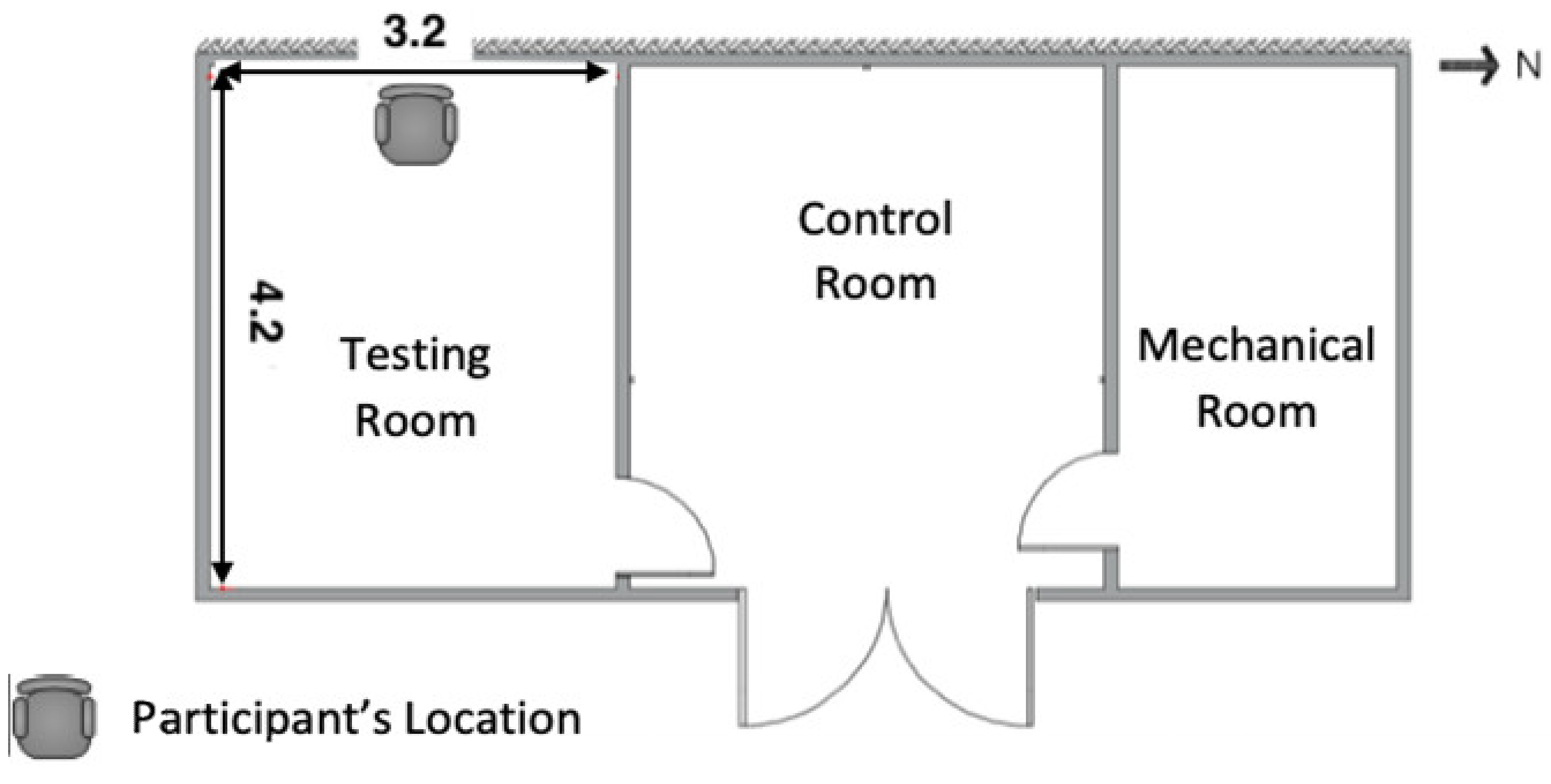
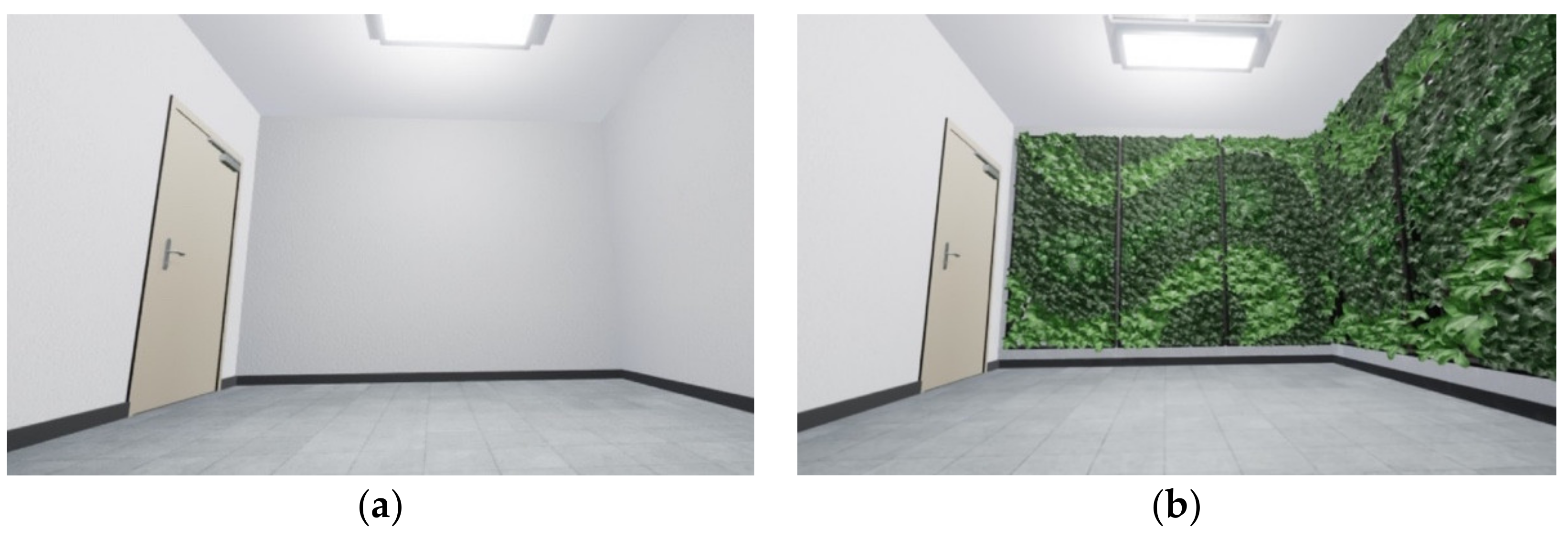
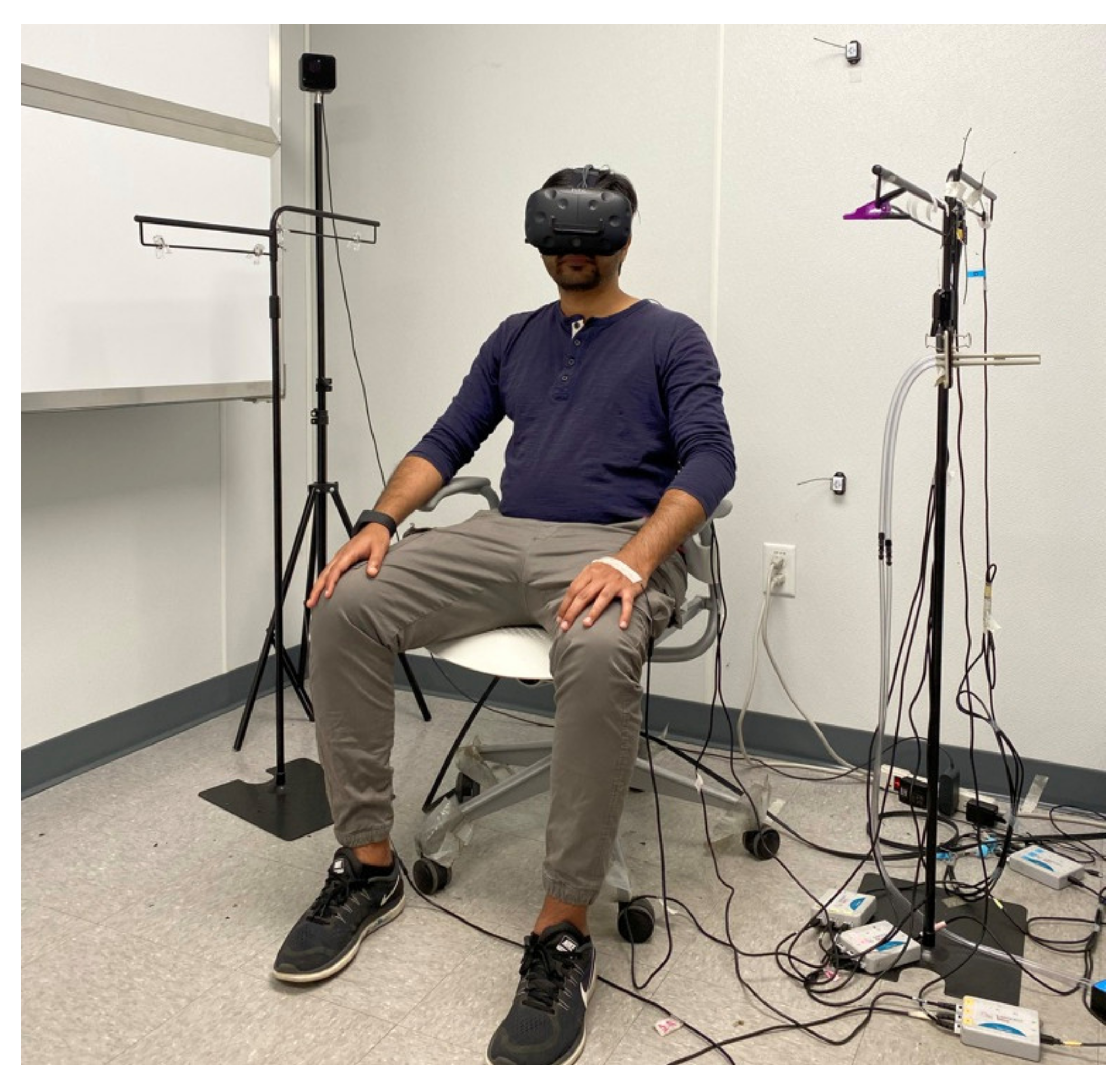




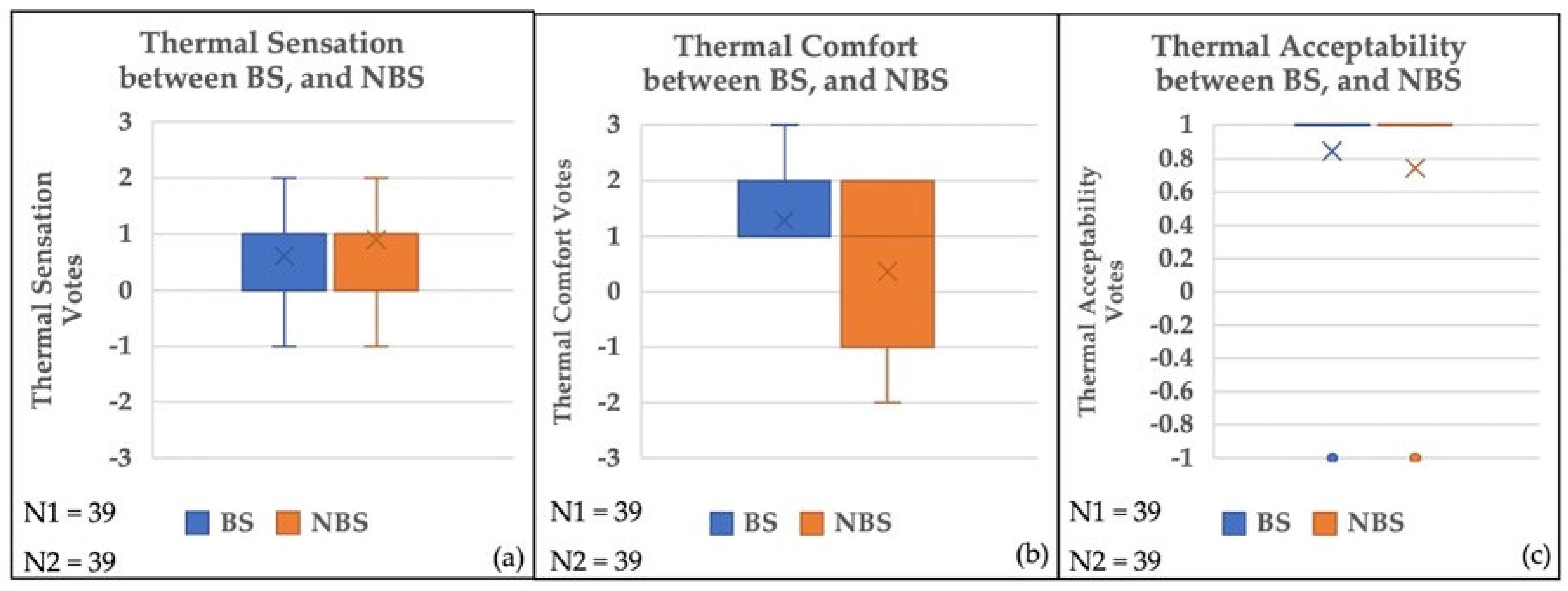

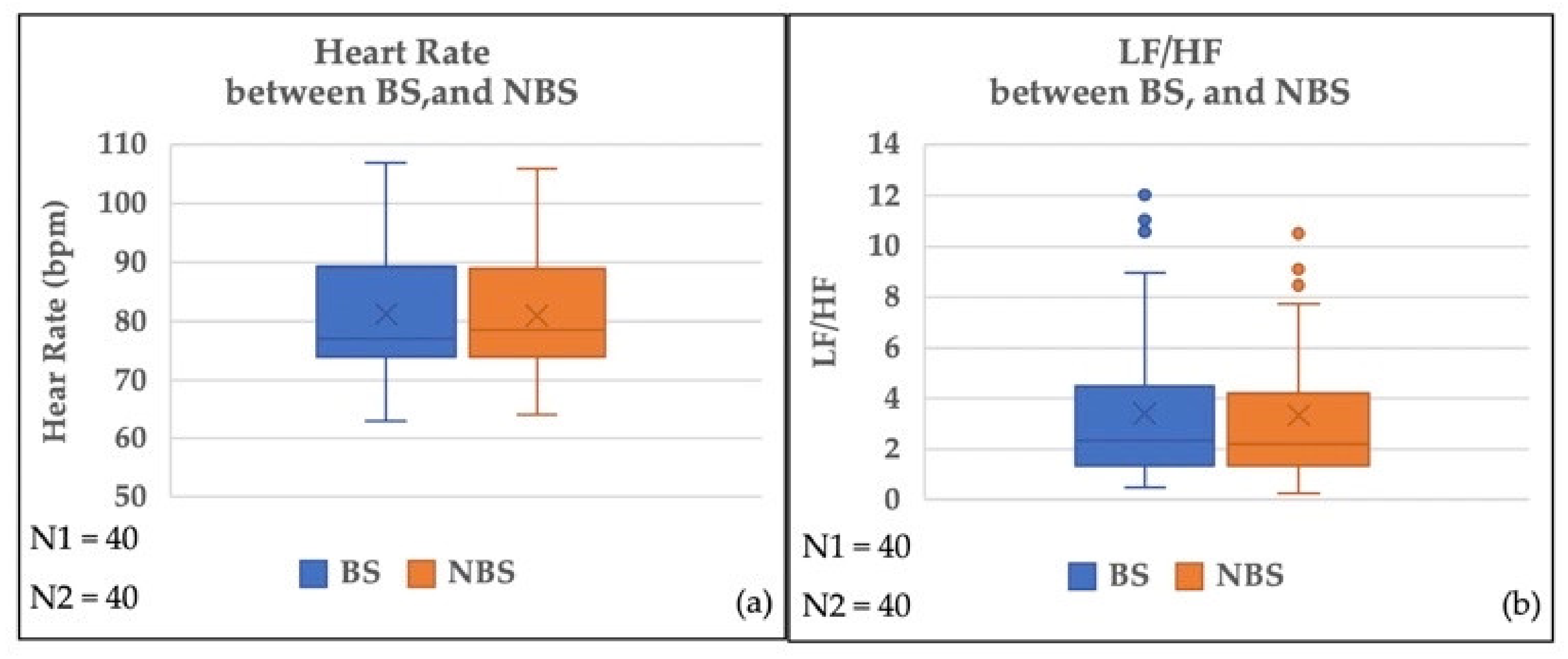
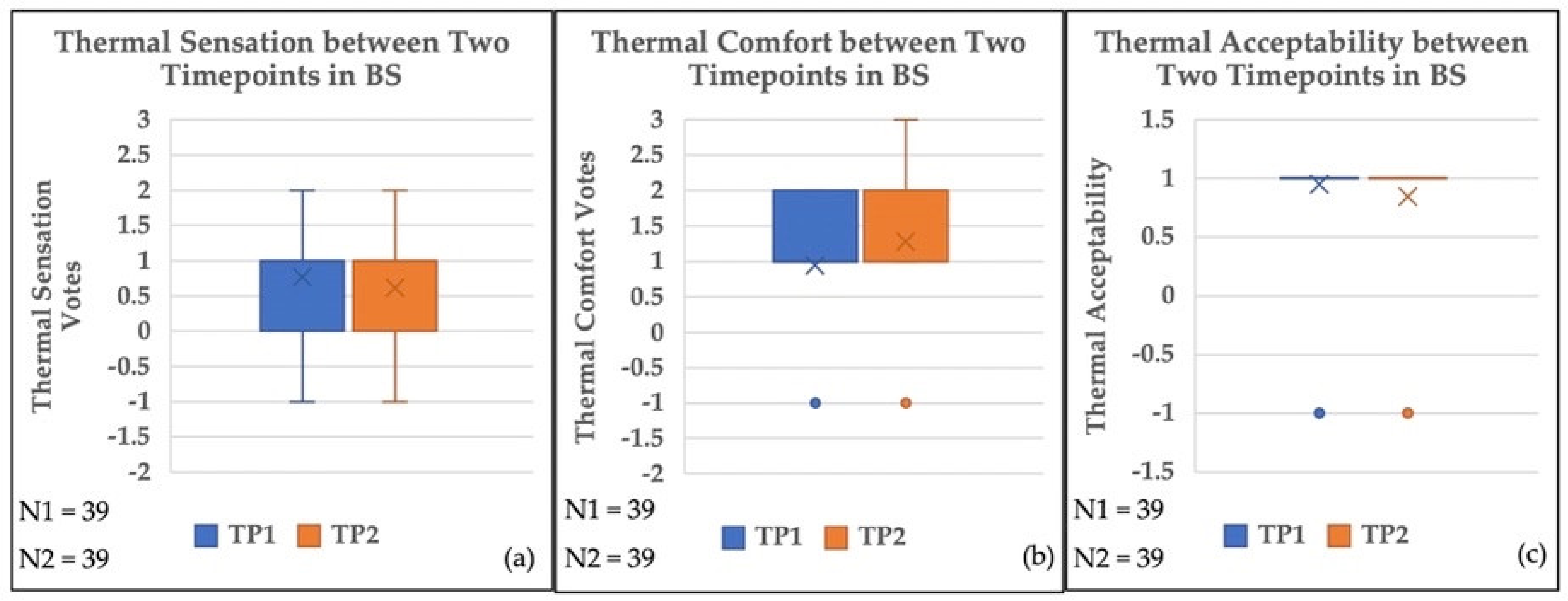
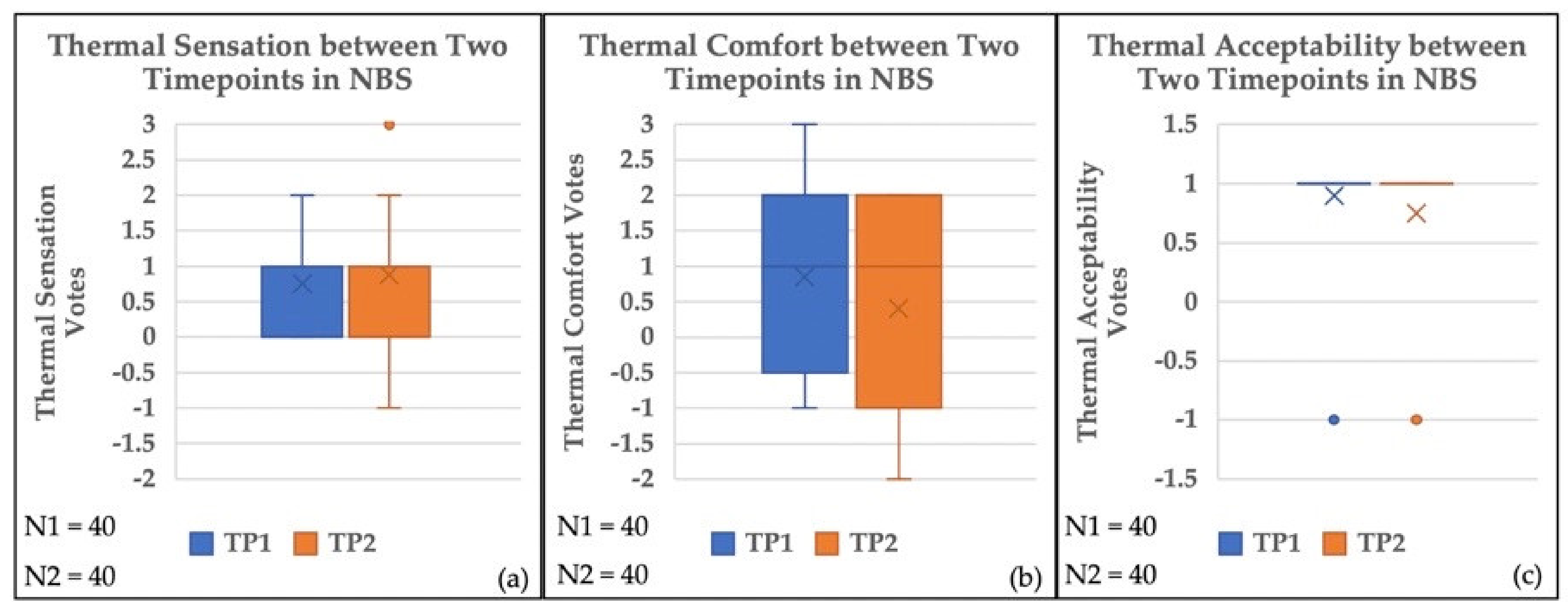
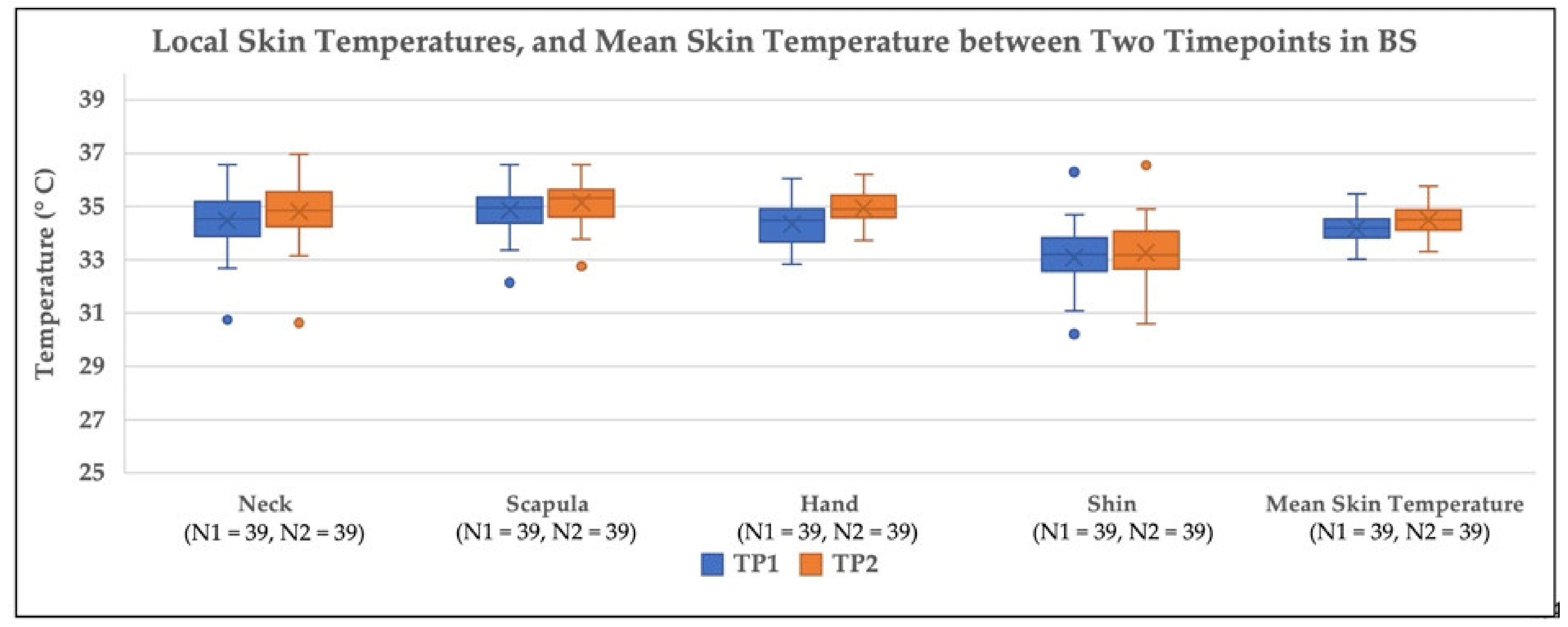
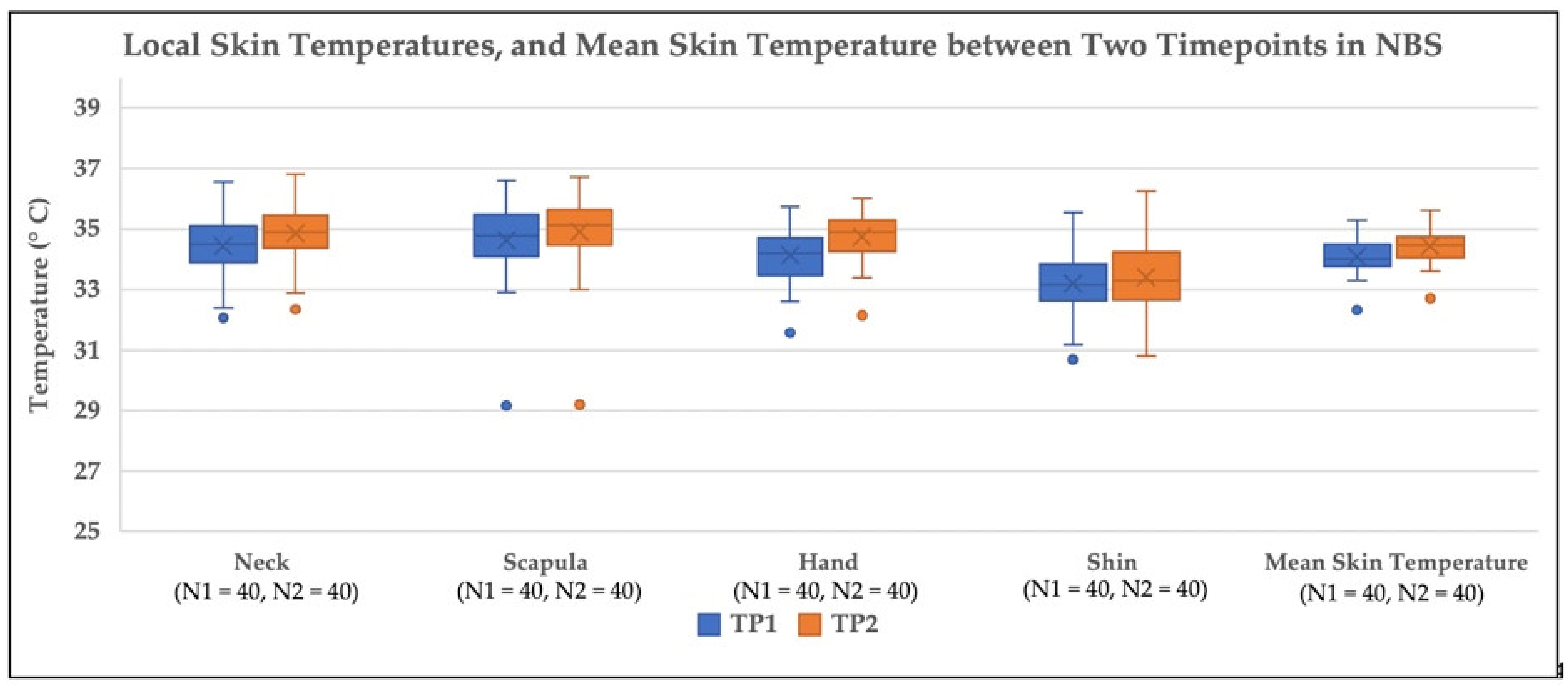


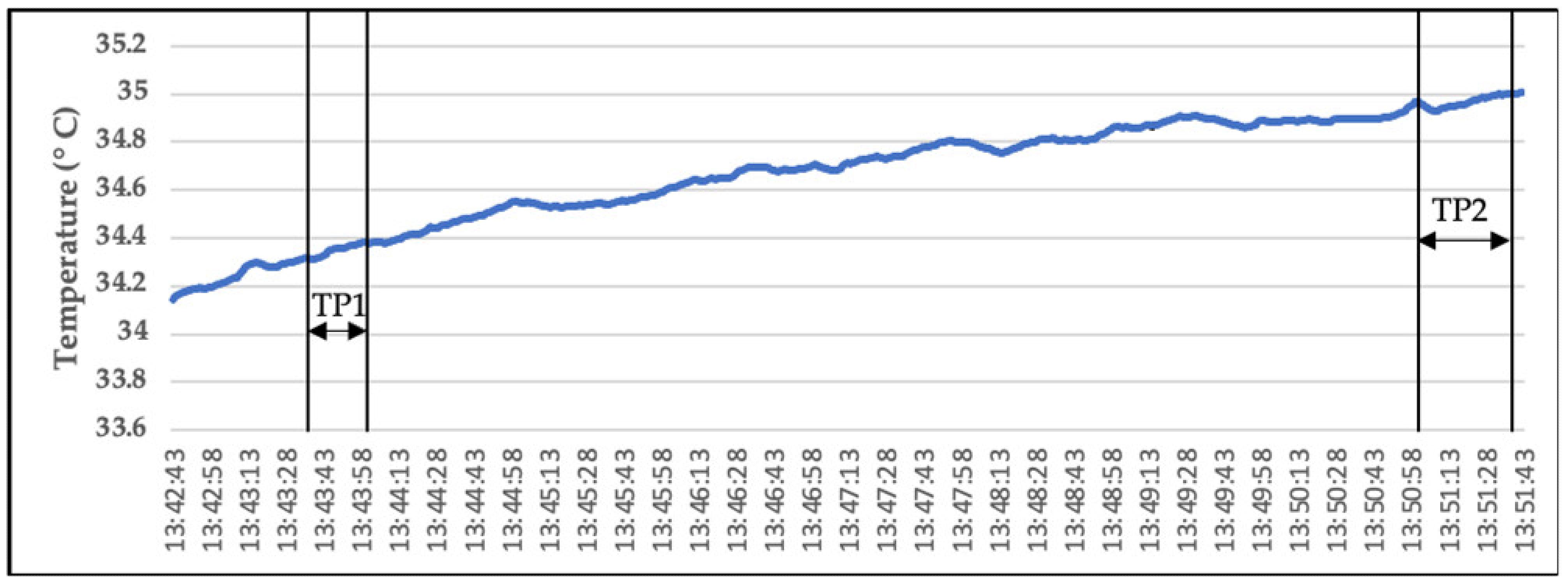


| Inclusion Criteria | |
| Age | 18–35 years |
| Sex | Men and women (non-pregnant by self-report) |
| Informed Consent | Participants must be able to read, understand, and sign the consent form |
| Exclusion Criteria | |
| Sufficient medical conditions (by using participants’ words) | Feeling or being under treatment for any type of health issues or discomfort. Individuals who had been hospitalized because of psychological illness within past five years or were currently undergoing treatment for severe mental illness. Any medical issues that can interfere or be aggravated by using the head-mounted display. |
| Thermal State | Mean ± SD | Wilcoxon Sign Rank Test (p-Value) (Significance Level, 0.05) | |
| BS | NBS | ||
| Sensation | 1.17 ± 0.7 | 1 ± 0.7 | 0.37 |
| Comfort | 0.5 ± 1.3 | 0.6 ± 1.28 | 0.83 |
| Acceptability | 0.6 ± 0.81 | 0.85 ± 0.53 | 0.11 |
| Δ mean | Thermal Sensation | Thermal Comfort | Thermal Acceptability | |
|---|---|---|---|---|
| Estimated Sample Sizes | 0.1 | 947 | 2121 | 487 |
| 0.25 | 152 | 400 | 78 | |
| 0.5 | 38 | 85 | 20 | |
| 0.75 | 17 | 38 | 9 | |
| 1 | 10 | 22 | 5 |
| Δ Mean | Skin Temperature | Δ Mean | Heart Rate |
|---|---|---|---|
| 0.25 °C | 251 | 1 bpm | 1738 |
| 0.5 °C | 62 | 4 bpm | 46 |
| 0.75 °C | 28 | 8 bpm | 27 |
| Age (Mean ± SD) | 27.67 ± 4.3 | |
| Alcohol or cigarettes (12 h before to the experiment) | 0 | |
| Intense Physical Activity (12 h before to the experiment) | 10% | |
| Departure Location | Off-campus | 55% |
| On-campus | 45% | |
| Type of Commute | Motorized Vehicles | 52.5% |
| Walking | 40% | |
| Cycling | 7.5% | |
| Between Session | BS | NBS | DF | t | p-Value | |||||
| N | Mean °C | St. DEV. | N | Mean °C | St. DEV. | |||||
| 40 | 29.017 | 0.08 | 40 | 29.024 | 0.08 | 39 | 0.54 | 0.59 | ||
| Within Sessions | TP1 | TP2 | DF | t | p-value | |||||
| N | Mean °C | St. DEV. | N | Mean °C | St. DEV. | |||||
| BS | 39 | 29.035 | 0.19 | 39 | 29.006 | 0.2 | 38 | 0.7 | 0.49 | |
| NBS | 40 | 28.972 | 0.18 | 40 | 29.017 | 0.19 | 39 | 1.33 | 0.19 | |
| Thermal State | BS | NBS | Wilcoxon Sign Rank Test (p-Value) (Significance Level, 0.05) | ||||
| N | Mean | St.DEV. | N | Mean | St.DEV. | ||
| Thermal Sensation | 39 | 0.62 | 0.75 | 39 | 0.9 | 0.85 | 0.0968 |
| Thermal Comfort | 39 | 1.28 | 1.19 | 39 | 0.36 | 1.44 | 0.0044 + |
| Thermal Acceptability | 39 | 0.85 | 0.54 | 39 | 0.74 | 0.68 | 0.4641 |
| Skin Temperature | BS | NBS | Two-Tailed Pairwise t-Test (p-Value) (Significance Level, 0.05) | ||||
| N | Mean °C | St.DEV. | N | Mean °C | St.DEV. | ||
| Neck | 40 | 34.652 | 1.06 | 40 | 34.65 | 0.98 | 0.98 |
| Scapula | 40 | 34.997 | 0.85 | 40 | 34.768 | 1.28 | 0.17 |
| Hand | 40 | 34.626 | 0.73 | 40 | 34.439 | 0.83 | 0.03 + |
| Shin | 40 | 33.215 | 1.15 | 40 | 33.303 | 1.13 | 0.4 |
| Mean Skin Temperature | 40 | 34.342 | 0.56 | 40 | 34.272 | 0.54 | 0.22 |
| BS | NBS | Two-Tailed Pairwise t-Test (p-Value) (Significance Level, 0.05) | |||||
| N | Mean | St.DEV. | N | Mean | St.DEV. | ||
| HR (bpm) | 40 | 81.25 | 10.68 | 40 | 80.9 | 10.26 | 0.55 |
| LF/HF | 40 | 3.41 | 3.02 | 40 | 3.32 | 2.8 | 0.84 |
| BS | TP1 | TP2 | Wilcoxon Sign Rank Test (p-Value) (Significance Level, 0.05) | ||||
| N | Mean | St.DEV. | N | Mean | St.DEV. | ||
| Thermal Sensation | 39 | 0.77 | 0.63 | 39 | 0.62 | 0.75 | 0.2179 |
| Thermal Comfort | 39 | 0.95 | 1.1 | 39 | 1.28 | 1.19 | 0.0755 |
| Thermal Acceptability | 39 | 0.95 | 0.32 | 39 | 0.85 | 0.54 | 0.3139 |
| NBS | TP1 | TP2 | Wilcoxon Sign Rank Test (p-Value) (Significance Level, 0.05) | ||||
| N | Mean | St.DEV. | N | Mean | St.DEV. | ||
| Thermal Sensation | 40 | 0.75 | 0.59 | 40 | 0.875 | 0.85 | 0.4283 |
| Thermal Comfort | 40 | 0.85 | 1.19 | 40 | 0.4 | 1.45 | 0.2670 |
| Thermal Acceptability | 40 | 0.9 | 0.44 | 40 | 0.75 | 0.67 | 0.2421 |
| BS | TP1 | TP2 | Two-Tailed Pairwise t-Test (p-Value) (Significance Level, 0.05) | ||||
| N | Mean °C | St. DEV. | N | Mean °C | St. DEV. | ||
| Neck | 39 | 34.476 | 1.08 | 39 | 34.803 | 1.13 | 7.69 × 10−9 |
| Scapula | 39 | 34.867 | 0.91 | 39 | 35.159 | 0.81 | 2.705 × 10−8 |
| Hand | 39 | 34.346 | 0.79 | 39 | 34.942 | 0.67 | 6.92 × 10−13 |
| Shin | 39 | 33.097 | 1.13 | 39 | 33.275 | 1.15 | 0.0035 |
| Mean Skin Temperature | 39 | 34.179 | 0.6 | 39 | 34.497 | 0.56 | 1.79 × 10−12 |
| NBS | TP1 | TP2 | Two-Tailed Pairwise t-Test (p-Value) (Significance Level, 0.05) | ||||
| N | Mean °C | St. DEV. | N | Mean °C | St. DEV. | ||
| Neck | 40 | 34.433 | 0.95 | 40 | 34.853 | 0.97 | 2.54 × 10−10 |
| Scapula | 40 | 34.634 | 1.29 | 40 | 34.901 | 1.28 | 2.59 × 10−10 |
| Hand | 40 | 34.127 | 0.93 | 40 | 34.748 | 0.77 | 7.18 × 10−10 |
| Shin | 40 | 33.198 | 1.11 | 40 | 33.415 | 1.19 | 0.0005 |
| Mean Skin Temperature | 40 | 34.095 | 0.54 | 40 | 34.447 | 0.56 | 2.94 × 10−13 |
| BS | TP1 | TP2 | Two-Tailed Pairwise t-test (p-Value) (Significance Level, 0.05) | ||||
| N | Mean | St.DEV. | N | Mean | St.DEV. | ||
| HR (bpm) | 40 | 82.63 | 11.55 | 40 | 82.19 | 11.01 | 0.48 |
| LF/HF | 40 | 3.13 | 3.17 | 40 | 3.35 | 3.74 | 0.76 |
| NBS | TP1 | TP2 | two-tailed pairwise t-test (p-Value) (significance level, 0.05) | ||||
| N | Mean | St.DEV. | N | Mean | St.DEV. | ||
| HR (bpm) | 39 | 82.02 | 10.47 | 39 | 81.78 | 10.66 | 0.62 |
| LF/HF | 39 | 3.07 | 3.06 | 39 | 3.18 | 3.03 | 0.86 |
| Thermal State | BS | NBS | Wilcoxon Sign Rank Test (p-Value) (Significance Level, 0.05) | ||||
| N | Mean | St.DEV. | N | Mean | St.DEV. | ||
| Thermal Sensation | 40 | 0.75 | 0.63 | 40 | 0.75 | 0.59 | 0.8978 |
| Thermal Comfort | 40 | 0.97 | 1.1 | 40 | 0.85 | 1.19 | 0.6139 |
| Thermal Acceptability | 40 | 0.95 | 0.32 | 40 | 0.9 | 0.44 | 0.5686 |
| TP1 | BS | NBS | DF | t | p-Value | ||||
| N | Mean °C | St.DEV. | N | Mean °C | St.DEV. | ||||
| 39 | 29.035 | 0.19 | 39 | 28.972 | 0.18 | 38 | 1.52 | 0.1369 | |
| Abbreviation | Abbreviation | ||
|---|---|---|---|
| BS | Biophilic Session | ST | Skin Temperature |
| HMD | Head-Mounted Display | TP1 | Time Point 1 |
| HR | Heart Rate | TP2 | Time point 2 |
| IVE | Immersive Virtual Environments | TSQ | Thermal State Questionnaire |
| NBS | Non-Biophilic Session | V (x) | Thermal State Votes |
| PR (x) | Physiological Response | V (s) | Thermal Sensation Votes |
| PR (st) | Physiological Response (skin temperature) | V (c) | Thermal Comfort Vote |
| PR (hr) | Physiological Response (heart rate) | V (a) | Thermal Acceptability Vote |
Publisher’s Note: MDPI stays neutral with regard to jurisdictional claims in published maps and institutional affiliations. |
© 2022 by the authors. Licensee MDPI, Basel, Switzerland. This article is an open access article distributed under the terms and conditions of the Creative Commons Attribution (CC BY) license (https://creativecommons.org/licenses/by/4.0/).
Share and Cite
Sedghikhanshir, A.; Zhu, Y.; Chen, Y.; Harmon, B. Exploring the Impact of Green Walls on Occupant Thermal State in Immersive Virtual Environment. Sustainability 2022, 14, 1840. https://doi.org/10.3390/su14031840
Sedghikhanshir A, Zhu Y, Chen Y, Harmon B. Exploring the Impact of Green Walls on Occupant Thermal State in Immersive Virtual Environment. Sustainability. 2022; 14(3):1840. https://doi.org/10.3390/su14031840
Chicago/Turabian StyleSedghikhanshir, Alireza, Yimin Zhu, Yan Chen, and Brendan Harmon. 2022. "Exploring the Impact of Green Walls on Occupant Thermal State in Immersive Virtual Environment" Sustainability 14, no. 3: 1840. https://doi.org/10.3390/su14031840
APA StyleSedghikhanshir, A., Zhu, Y., Chen, Y., & Harmon, B. (2022). Exploring the Impact of Green Walls on Occupant Thermal State in Immersive Virtual Environment. Sustainability, 14(3), 1840. https://doi.org/10.3390/su14031840







